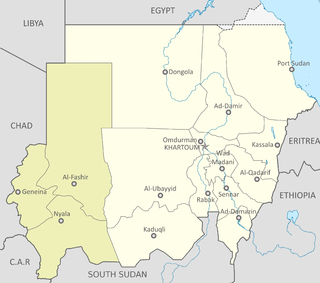
Darfur is a region of western Sudan. Dār is an Arabic word meaning "home [of]" – the region was named Dardaju while ruled by the Daju, who migrated from Meroë c. 350 AD, and it was renamed Dartunjur when the Tunjur ruled the area. Darfur was an independent sultanate for several hundred years until 1874, when it fell to the Sudanese warlord Rabih az-Zubayr. The region was later invaded and incorporated into Sudan by Anglo-Egyptian forces in 1916. As an administrative region, Darfur is divided into five federal states: Central Darfur, East Darfur, North Darfur, South Darfur and West Darfur. Because of the War in Darfur between Sudanese government forces and the indigenous population, the region has been in a state of humanitarian emergency and genocide since 2003. The factors include religious and ethnic rivalry, and the rivalry between farmers and herders.

The Second Sudanese Civil War was a conflict from 1983 to 2005 between the central Sudanese government and the Sudan People's Liberation Army. It was largely a continuation of the First Sudanese Civil War of 1955 to 1972. Although it originated in southern Sudan, the civil war spread to the Nuba mountains and the Blue Nile. It lasted for almost 22 years and is one of the longest civil wars on record. The war resulted in the independence of South Sudan 6 years after the war ended.
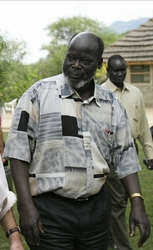
John Garang de Mabior was a Sudanese politician and revolutionary leader. From 1983 to 2005, he led the Sudan People's Liberation Army (SPLA) during the Second Sudanese Civil War. He briefly served as First Vice President of Sudan for three weeks, from the comprehensive peace agreement of 2005 until his death in a helicopter crash on July 30, 2005. A developmental economist by profession, Garang was a major influence on the movement that led to the foundation of South Sudan.

Sadiq al-Mahdi, also known as Sadiq as-Siddiq, was a Sudanese political and religious figure who was Prime Minister of Sudan from 1966 to 1967 and again from 1986 to 1989. He was head of the National Umma Party and Imam of the Ansar, a Sufi order that pledges allegiance to Muhammad Ahmad (1844–1885), who claimed to be the Mahdi, the messianic saviour of Islam.
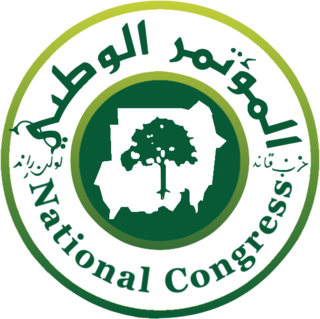
The National Congress Party was a major political party that dominated domestic politics in Sudan from its foundation until the Sudanese Revolution.
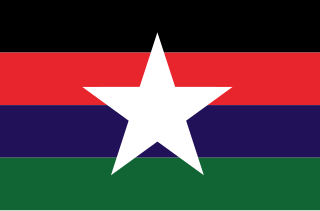
The Sudan Liberation Movement/Army is a Sudanese rebel group active in Darfur, Sudan. It was founded as the Darfur Liberation Front by members of three indigenous ethnic groups in Darfur: the Fur, the Zaghawa, and the Masalit, among whom were the leaders Abdul Wahid al Nur of the Fur and Minni Minnawi of the Zaghawa.

Dr. Khalil Ibrahim was a Sudanese insurgent leader who was the founder of the Justice and Equality Movement (JEM).
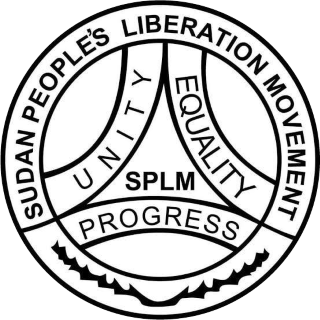
The Sudan People's Liberation Movement is a political party in South Sudan. It was initially founded as the political wing of the Sudan People's Liberation Army in 1983. On January 9, 2005 the SPLA, the SPLM and the Government of Sudan signed the Comprehensive Peace Agreement, ending the civil war. SPLM then obtained representation in the Government of Sudan, and was the main constituent of the Government of the then semi-autonomous Southern Sudan. When South Sudan became a sovereign state on 9 July 2011, SPLM became the ruling party of the new republic. SPLM branches in Sudan separated themselves from SPLM, forming the Sudan People's Liberation Movement–North. Further factionalism appeared as a result of the 2013–2014 South Sudanese Civil War, with President Salva Kiir leading the SPLM-Juba and former Vice President Riek Machar leading the Sudan People's Liberation Movement-in-Opposition.

This article covers the period of the history of Sudan between 1985 and 2019 when the Sudanese Defense Minister Abdel Rahman Swar al-Dahab seized power from Sudanese President Gaafar Nimeiry in the 1985 Sudanese coup d'état. Not long after, Lieutenant General Omar al-Bashir, backed by an Islamist political party, the National Islamic Front, overthrew the short lived government in a coup in 1989 where he ruled as President until his fall in April 2019. During Bashir's rule, also referred to as Bashirist Sudan, he was re-elected three times while overseeing the independence of South Sudan in 2011. His regime was criticized for human rights abuses, atrocities and genocide in Darfur and allegations of harboring and supporting terrorist groups in the region while being subjected to United Nations sanctions beginning in 1995, resulting in Sudan's isolation as an international pariah.

The War in Darfur, also nicknamed the Land Cruiser War, was a major armed conflict in the Darfur region of Sudan that began in February 2003 when the Sudan Liberation Movement (SLM) and the Justice and Equality Movement (JEM) rebel groups began fighting against the government of Sudan, which they accused of oppressing Darfur's non-Arab population. The government responded to attacks by carrying out a campaign of ethnic cleansing against Darfur's non-Arabs. This resulted in the death of hundreds of thousands of civilians and the indictment of Sudan's president, Omar al-Bashir, for genocide, war crimes, and crimes against humanity by the International Criminal Court.

The Libyan–Sudanese relations refers to the long historical relations between Libya and Sudan, both are Arab countries.
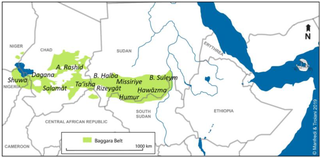
The Beni Halba is an Arab group located in the western Sudanese region of Darfur. The Beni Halba is one of the major Darfuri Baggara groups, along with the Habbaniya, Rizeigat and Ta’isha, and was granted a large hakura in southern Darfur by the sultans of independent Dar Fur. During the 1980s, recurring drought in Chad prompted several clans of Beni Halba to migrate eastwards and join their kinspeople between Geneina and Kebkabiya and Kutum. In the late 1980s, the ideology then sweeping through the region combining Arab supremacy and Islamic extremism was taken up by many Beni Halba. Under Nazir al-Hadi Issa Debaker, the Beni Halba were actively involved in attacks upon the Fur people starting in 1987 through 1989. In this period a new militia called the Janjaweed, partially drawing upon the Beni Halba, was first formed. In 1991 the Sudan People's Liberation Army, then fighting the Second Sudanese Civil War in the south of the country, sent a force under Daud Bolad to expand the conflict into Darfur. However, Bolad's force was annihilated by a combination of the army and Beni Halba fursan ("horsemen"), who then carried out reprisal attacks against Fur civilians. As a result, the Beni Halba district town of Idd al Ghanam was renamed Idd al Fursan.

Throughout its history, Darfur has been the home to several cultures and kingdoms, such as the Daju and Tunjur kingdoms. The recorded history of Darfur begins in the seventeenth century, with the foundation of the Fur Sultanate by the Keira dynasty. In 1875, the Anglo-Egyptian condominium in Khartoum ended the dynasty. The British allowed Darfur a measure of autonomy until formal annexation in 1916. However, the region remained underdeveloped through the period of colonial rule and after independence in 1956. The majority of national resources were directed toward the riverine Arabs clustered along the Nile near Khartoum. This pattern of structural inequality and overly underdevelopment resulted in increasing restiveness among Darfuris. The influence of regional geopolitics and war by proxy, coupled with economic hardship and environmental degradation, from soon after independence led to sporadic armed resistance from the mid-1980s. The continued violence culminated in an armed resistance movement around 2003.

Daud Yahya Ibrahim Bolad was a Sudanese politician and rebel leader.
The National Redemption Front (NRF) is an alliance of opposition groups in Darfur, Sudan. According to their foundation declaration, the NRF consists of the Justice and Equality Movement (JEM), a holdout faction of the Sudan Liberation Movement/Army (SLM/A) and the Sudan Federal Democratic Alliance (SFDA). The NRF opposes the Darfur Peace Agreement, signed by the SLA faction led by Minni Minnawi and the Sudanese government on 5 May 2006. The group was formed in late June 2006, after the Abuja Agreement and is led by Ahmed Diraige.
The Islamic Legion was a Libyan-sponsored pan-Arabist and pan-Islamist paramilitary force, created in 1972. The Legion was part of Muammar Gaddafi's dream of creating the Great Islamic State of the Sahel.

The Sudan Revolutionary Front, or the Sudanese Revolutionary Front (SRF), is an alliance between Sudanese factions that was created in opposition to the government of President Omar al-Bashir. It was declared on 12 November 2011, following several months of support by Darfuri rebel groups for the Sudan People's Liberation Movement-North in the conflict in South Kordofan and Blue Nile.

The Seekers of Truth and Justice were a political-action group operating from the mid-1990s to the early 2000s in Sudan. The group was founded by Khalil Ibrahim and eventually evolved into the Justice and Equality Movement (JEM) in the early 2000s, marked by their creation and distribution of a controversial document entitled "The Black Book". Their relationship with the government in Khartoum was hostile at best and only increased in tension as the organization developed.
Operation Thunderbolt was the codename for a military offensive by the South Sudanese SPLA rebel group and its allies during the Second Sudanese Civil War. The operation aimed at conquering several towns in Western and Central Equatoria, most importantly Yei, which served as strongholds for the Sudanese Armed Forces (SAF) and helped the Sudanese government to supply its allies, the Ugandan insurgents of the WNBF and UNRF (II) based in Zaire. These pro-Sudanese forces were defeated and driven from Zaire by the SPLA and its allies, namely Uganda and the AFDL, in course of the First Congo War, thus allowing the SPLA launch Operation Thunderbolt from the Zairian side of the border. Covertly supported by expeditionary forces from Uganda, Ethiopia, and Eritrea, the SPLA's offensive was a major success, with several SAF garrison towns falling to the South Sudanese rebels in a matter of days. Yei was encircled and put under siege on 11 March 1997. At the same time, a large group of WNBF fighters as well as SAF, FAZ, and ex-Rwandan Armed Forces soldiers was trying to escape from Zaire to Yei. The column was ambushed and destroyed by the SPLA, allowing it to capture Yei shortly afterward. Following this victory, the South Sudanese rebels continued their offensive until late April, capturing several other towns in Equatoria and preparing further anti-government campaigns.
Tajammu al-Arabi, translated into English as Arab Gathering or Arab Alliance, was a Sudanese Arab tribal militia and political organization that operated in western Sudan and eastern Chad in the late 1980s under Libyan sponsorship. The organization was organized by tribal leaders and Islamic Legion militants in the context of the ethno-tribal conflicts that were taking place in Darfur between the Baggara Arabs and the Furs in those years. Although the organization claimed that its aim was solely to represent and defend the interests of Arab tribes, the organization was described by Gérard Prunier as "a militantly racist and pan-Arabist organization which stressed the 'Arab' character of the province." Scholars agree that Tajammu al-Arabi played an important role in the creation of the Janjaweed, which still operate in the region to this day.